
Difference: APPX500LinuxUpgradeInstallation (20 vs. 21)
Revision 212014-12-05 - JeanNeron
| Line: 1 to 1 | ||||||||
|---|---|---|---|---|---|---|---|---|
APPX Linux/Unix - APPX 5 Upgrade Instructions | ||||||||
| Line: 40 to 40 | ||||||||
| Change the permissions on the downloaded installer file (APPX4to5upgrade_linux.sh) to have Execute permissions. | ||||||||
| Changed: | ||||||||
| < < | 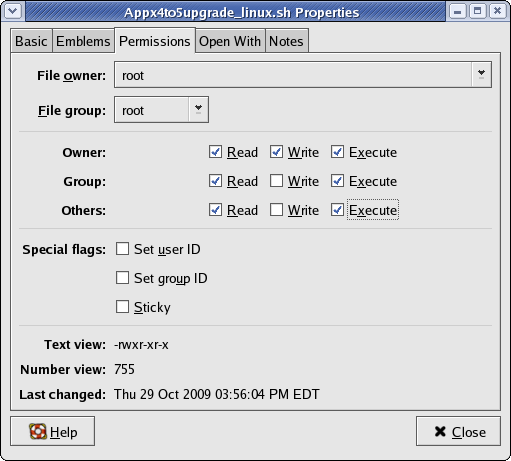 | |||||||
| > > |  | |||||||
| Run the installer file (APPX4to5upgrade_linux.sh). If you are presented with a "Run or Display?" screen similar to the one below, click on the "Run" button. | ||||||||
| Changed: | ||||||||
| < < | 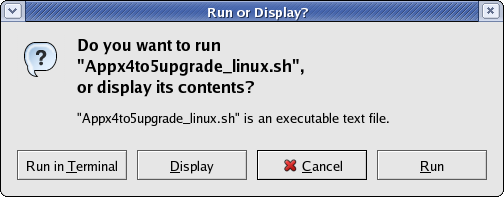 | |||||||
| > > |  | |||||||
| After a few moments, the APPX 4.2 to 5.0 Upgrade Application Setup Wizard should display the Welcome screen. Click on the "Next" button to continue. | ||||||||
| Changed: | ||||||||
| < < |  | |||||||
| > > |  | |||||||
| Read the Installation Instructions and then click on the "Next" button to continue. | ||||||||
| Changed: | ||||||||
| < < | 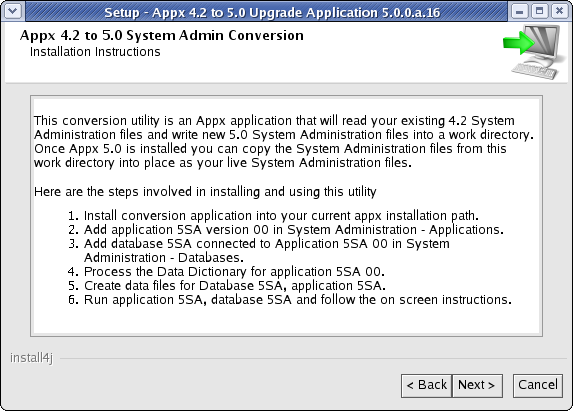 | |||||||
| > > |  | |||||||
| Specify the Destination Directory into which the upgrade utility is to be installed. The directory that you specify must be the directory where APPX 4.2.a is installed on your system. As a matter of convention, this directory is usually "/usr/local/appx/". | ||||||||
| Changed: | ||||||||
| < < | 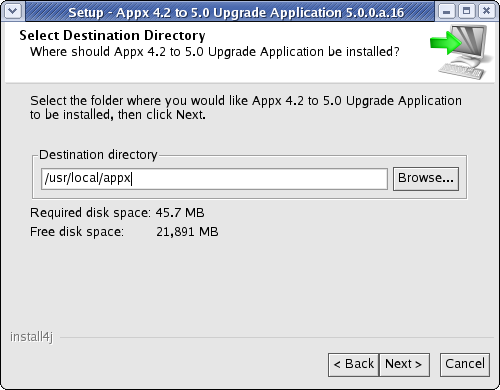 | |||||||
| > > |  | |||||||
| The APPX Upgrade Application (5SA Version 00) will then be installed into the specified destination directory. | ||||||||
| Changed: | ||||||||
| < < | 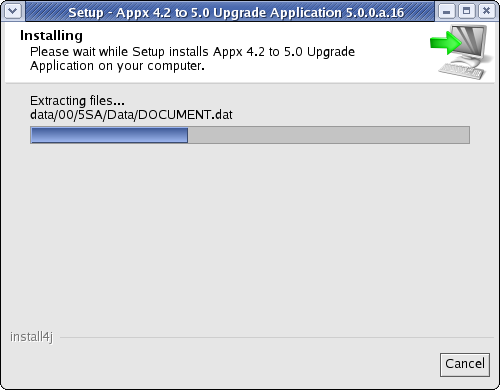 | |||||||
| > > |  | |||||||
| When the installation wizard displays the final screen, click on the Finish button to end the installation wizard. | ||||||||
| Changed: | ||||||||
| < < | 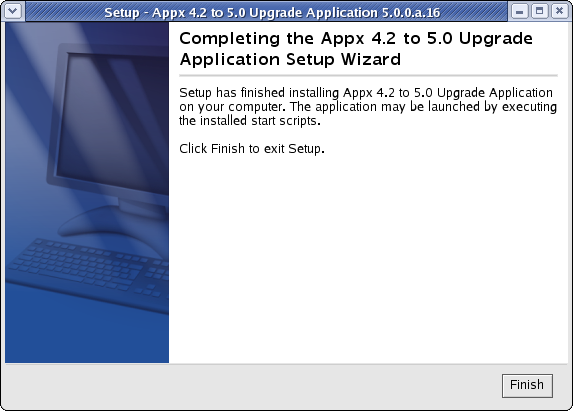 | |||||||
| > > |  | |||||||
Character Mode Installation | ||||||||
| Added: | ||||||||
| > > | ||||||||
If you don't have access to a GUI you can run the this installer in character mode by appending "-c" to the command line. After a few moments, the Appx Setup Wizard should display the Welcome message. Press Enter to continue the installation.
# ./Appx4to5upgrade_linux.sh -cUnpacking JRE ... Preparing JRE ... Starting Installer ... This will install Appx 4.2 to 5.0 Upgrade Application on your computer. OK [o, Enter], Cancel [c] | ||||||||
| Line: 91 to 92 | ||||||||
| Add the upgrade application (5SA 00) to the Applications file. | ||||||||
| Changed: | ||||||||
| < < | 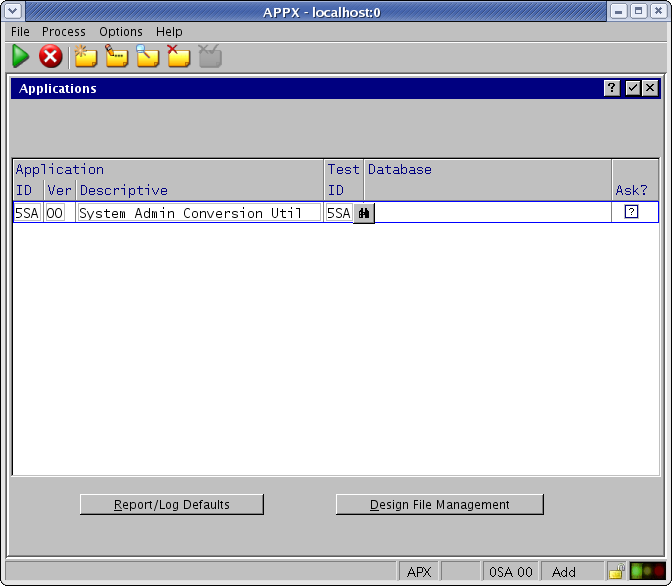 | |||||||
| > > |  | |||||||
| Create the Design Files for Application 5SA. APPX should report "File Already Exists" for each file. If not, the application was not installed in the correct location. Repeat the installation steps above, specifing the correct location | ||||||||
| Changed: | ||||||||
| < < | 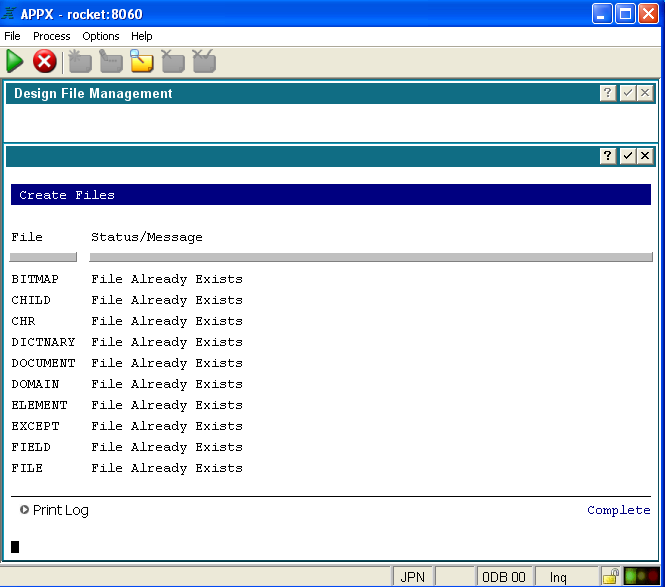 | |||||||
| > > |  | |||||||
| Add the database (5SA) for the Upgrade Application to the Databases file. | ||||||||
| Changed: | ||||||||
| < < | 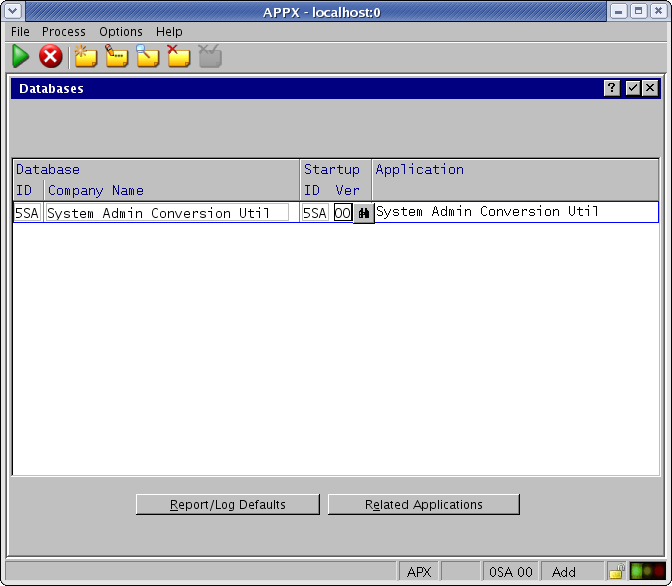 | |||||||
| > > |  | |||||||
| Run Database Management for the Upgrade Application and Database. | ||||||||
| Changed: | ||||||||
| < < | 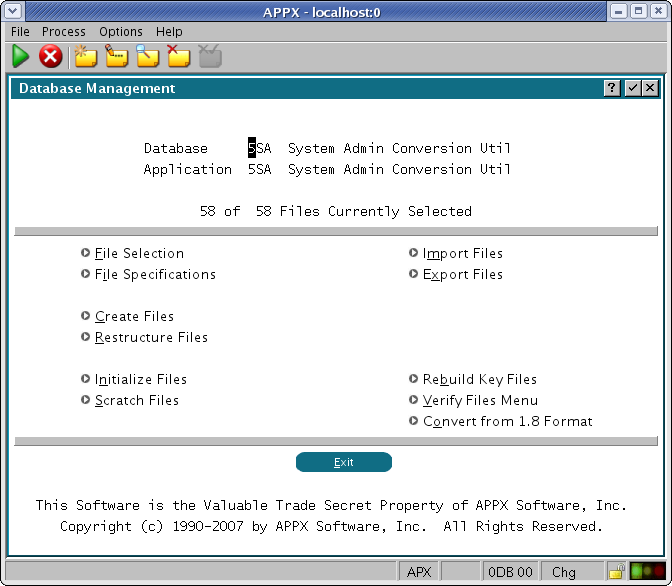 | |||||||
| > > |  | |||||||
| Run Create Files. | ||||||||
| Changed: | ||||||||
| < < | 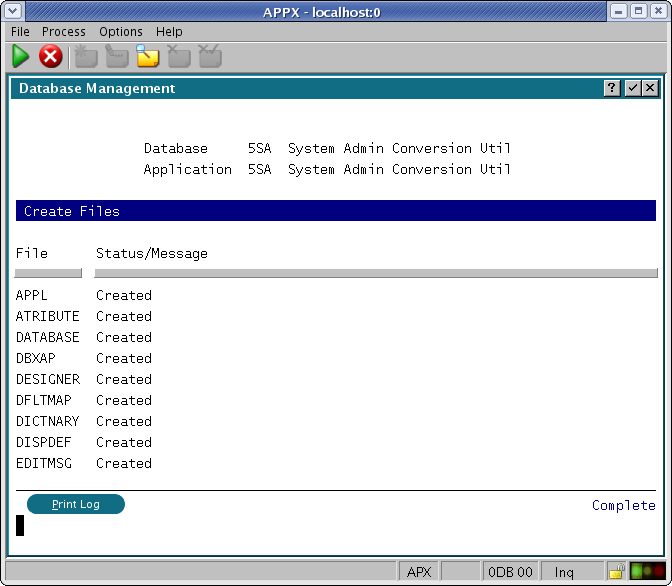 | |||||||
| > > |  | |||||||
Run the Upgrade ApplicationAfter configuring the Upgrade Application, you must run the Upgrade Utility to convert your System Administration files. | ||||||||
| Changed: | ||||||||
| < < | 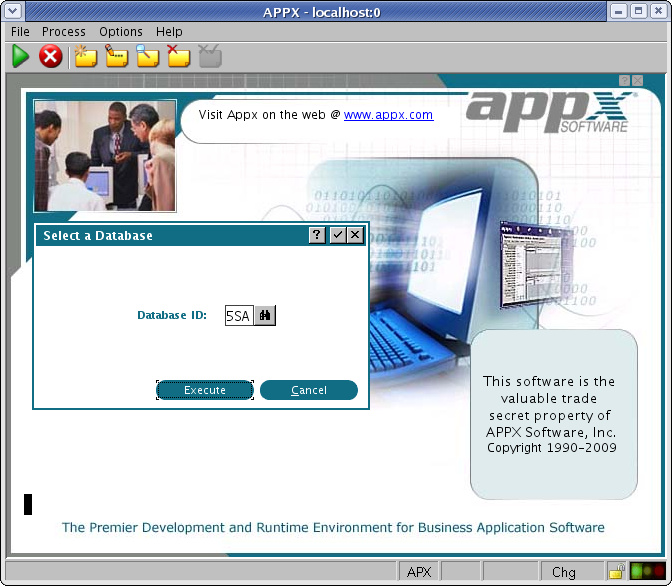 | |||||||
| > > |  | |||||||
| Click on the "Convert" button to run the conversion utility. | ||||||||
| Changed: | ||||||||
| < < | 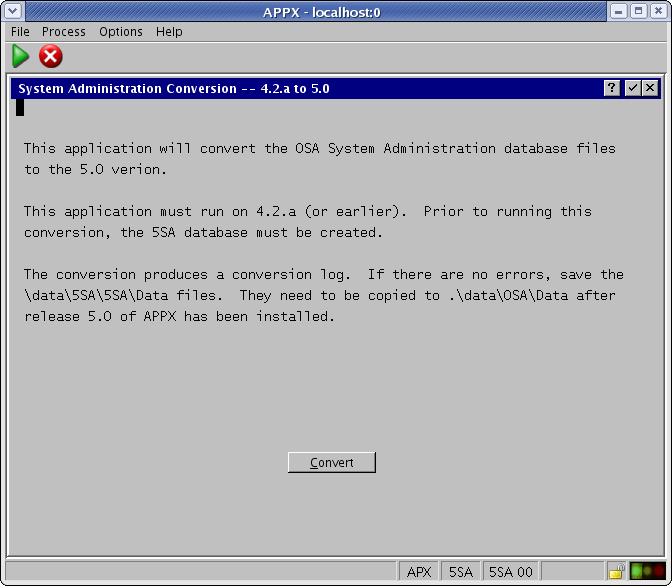 | |||||||
| > > |  | |||||||
| The conversion utility will create a log. Specify the appropriate disposition options to print the conversion log. | ||||||||
| Changed: | ||||||||
| < < | 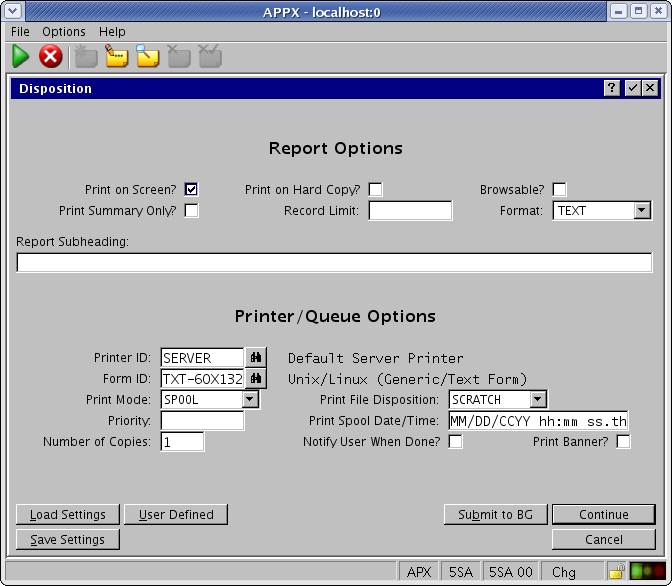 | |||||||
| > > |  | |||||||
| The conversion log will inform you of any problems that may have been encountered while running the conversion utility. | ||||||||
| Changed: | ||||||||
| < < | 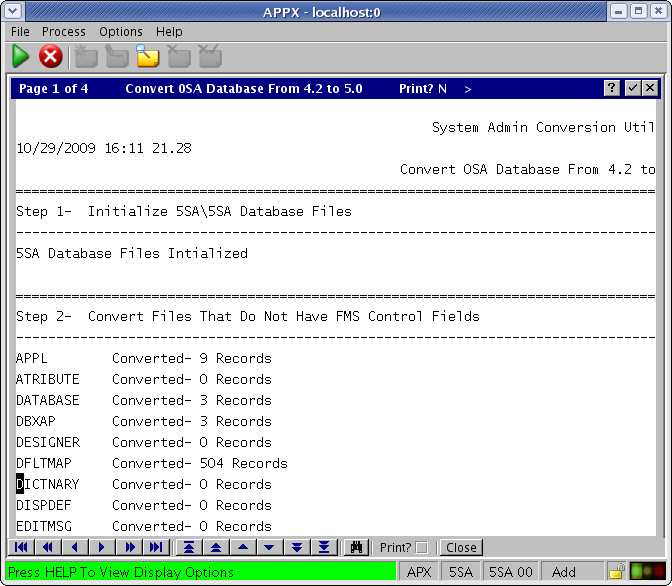 | |||||||
| > > |  | |||||||
Install the Upgraded System Administration FilesYou are almost ready to install Release 5 on top of your existing installation. Before actually installing APPX, you should: | ||||||||
| Line: 138 to 139 | ||||||||
| You should also remove the System Administration structure files. You can use a "rm" command similar to the example below to remove your System Administration structure files. Be sure to edit the rm command to reference the directory where APPX is installed on your system if APPX is not installed in "/usr/local/appx". rm -f /usr/local/appx/data/0SA/Struct/* | ||||||||
| Changed: | ||||||||
| < < | Install APPX 5.0.0 or 5.1.0 | |||||||
| > > | Install APPX 5.x | |||||||
| Changed: | ||||||||
| < < | Now follow these steps to install APPX 5.0.0 or 5.1.0: | |||||||
| > > | Now follow these steps to install APPX 5.x: | |||||||
| Changed: | ||||||||
| < < | OverviewTwo different methods are provided to install APPX on Linux/Unix. There is a GUI installer and a Console Mode (character mode) installer. The same installer is used for both methods. The installer will automatically detect if it is being run as a command or from a GUI Desktop, although in some cases you may have to add "-c" to the command line to force the character installer. Regardless of which installation method is used, the result is the same. A typical APPX installation on a system where APPX has not been previously installed performs the following steps:
GUI Installation on Linux/UnixLog in to your system as the "root" user. Download the APPX/Linux GUI installer (appxsetup.sh) from the APPX web site or the APPX ftp server and save it to your Desktop or to any other suitable folder. The following instructions will refer to the appxsetup.sh file, which is the name of the Linux installer. The installers for other operating systems have similar names, ie, appxsetup-aix.sh for AIX, appxsetup-sun.sh for Solaris, and so on. if you are downloading directly from the ftp site, make sure you choose the correct installer for your O/S, and substitute your installer's name in the following instructions. Change the permissions on the downloaded installer file to have Execute permissions.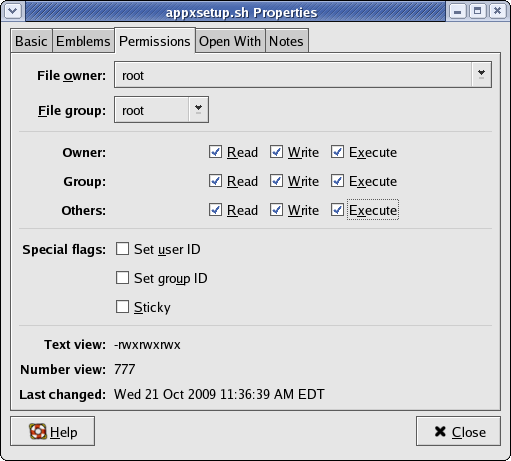 Run the installer file (appxsetup.sh). If you are presented with a "Run or Display?" screen similar to the one below, click on the "Run" button.
Run the installer file (appxsetup.sh). If you are presented with a "Run or Display?" screen similar to the one below, click on the "Run" button.
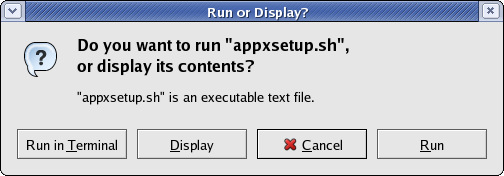 After a few moments, the APPX Setup Wizard should display the Welcome screen. Click on the "Next" button to continue.
After a few moments, the APPX Setup Wizard should display the Welcome screen. Click on the "Next" button to continue.
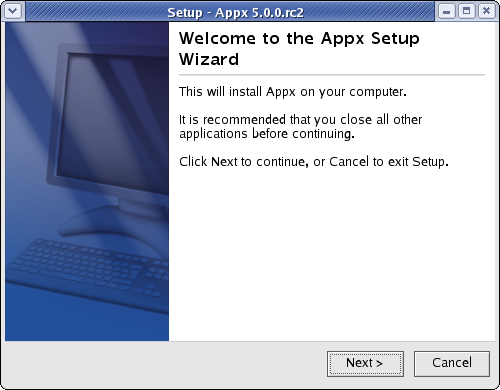 Read and accept the license agreement.
Read and accept the license agreement.
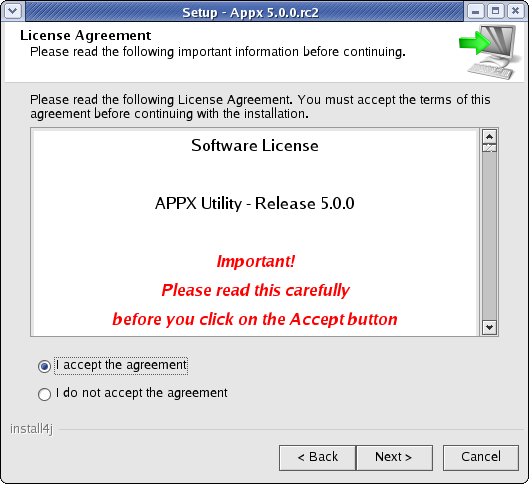 Specify the Destination Directory into which APPX is to be installed. As a matter of convention, APPX is usually installed into /usr/local/appx but may be installed into the directory of your choice.
Specify the Destination Directory into which APPX is to be installed. As a matter of convention, APPX is usually installed into /usr/local/appx but may be installed into the directory of your choice.
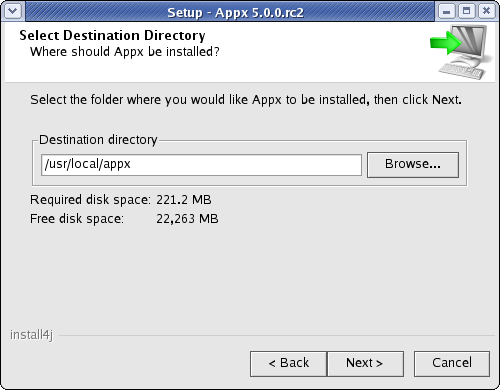 You will be warned if the destination directory already exists. Otherwise, the APPX Setup Wizard will create it.
You will be warned if the destination directory already exists. Otherwise, the APPX Setup Wizard will create it.
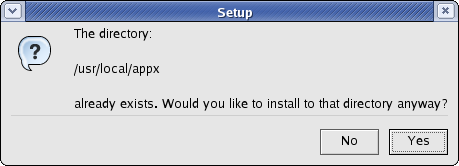 APPX will then be installed into the specified destination directory.
APPX will then be installed into the specified destination directory.
 When the APPX Setup Wizard displays the final screen, click on the Finish button to end the APPX Setup Wizard and to automatically run APPX to complete the configuration and installation of APPX.
When the APPX Setup Wizard displays the final screen, click on the Finish button to end the APPX Setup Wizard and to automatically run APPX to complete the configuration and installation of APPX.
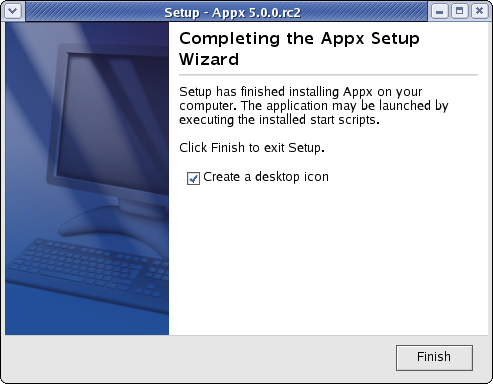 When you click on the Finish button, an APPX session will be automatically launched to APPX500NewInstallConfigAPPX of the APPX environment.
Finally, if you intend to log into APPX as user "appx", then you must add a password for the "appx" o/s user that was created by the installer (use the "passwd appx" command).
After completing the above steps, you should be able to login to APPX as user "appx" from a remote desktop using the ADC.
When you click on the Finish button, an APPX session will be automatically launched to APPX500NewInstallConfigAPPX of the APPX environment.
Finally, if you intend to log into APPX as user "appx", then you must add a password for the "appx" o/s user that was created by the installer (use the "passwd appx" command).
After completing the above steps, you should be able to login to APPX as user "appx" from a remote desktop using the ADC.
Character Mode InstallationIf you don't have access to a GUI, you can run the Appx installer in character mode by appending "-c" to the command line. After a few moments, the Appx Setup Wizard should display the Welcome message. Press Enter to continue the installation.
On some systems the Java based installer may fail to run with a notice as shown below even though you are supplying the -c argument. In this case, make sure you have dejavu-sans-font package installed, and also that you have a non headless version of a JRE available to the installer. You can do that with the following yum command on RHEL8.
yum install dejavu-sans-fonts java-1.8.0-openjdk
Could not display the GUI. This application needs access to an X Server.
*******************************************************************
You can also run this application in console mode without
access to an X server by passing the argument -c
*******************************************************************
[root@rhel8 Downloads]#
# ./appxsetup.sh -c
Unpacking JRE ... Preparing JRE ... Starting Installer ... This will install Appx on your computer. OK [o, Enter], Cancel [c]
Next, read and accept the License agreement. Press Enter as each page is displayed. Please read the following License Agreement. You must accept the terms of this agreement before continuing with the installation. Software License APPX Utility - Release 5.0.0 _ Important! _ Please read this carefully before you click on the Accept button. Definitions: "Software License Agreement (SLA)" shall mean this Software License document and the associated *License Key document collectively. [Enter] After the agreement has been displayed, enter 1 to accept the license agreement, or 2 to cancel the installation. . . . For inquires regarding this agreement, please contact: APPX Software, Inc., 11363 San Jose Blvd., Suite 301, Jacksonville, Florida 32223, USA I accept the agreement Yes [1], No [2] Choose the directory where APPX should be installed and the other installation options. Where should Appx be installed? [/appx50] Create a desktop icon? Yes [y, Enter], No [n] Create a Quick Launch icon? Yes [y, Enter], No [n] | |||||||
| > > | OverviewTwo different methods are provided to install APPX on Linux/Unix. There is a GUI installer and a Console Mode (character mode) installer. The same installer is used for both methods. The installer will automatically detect if it is being run as a command or from a GUI Desktop, although in some cases you may have to add "-c" to the command line to force the character installer. Regardless of which installation method is used, the result is the same. A typical APPX installation on a system where APPX has not been previously installed performs the following steps:
GUI Installation on Linux/UnixLog in to your system as the "root" user. Download the APPX/Linux GUI installer (appxsetup.sh) from the APPX web site or the APPX ftp server and save it to your Desktop or to any other suitable folder. The following instructions will refer to the appxsetup.sh file, which is the name of the Linux installer. The installers for other operating systems have similar names, ie, appxsetup-aix.sh for AIX, appxsetup-sun.sh for Solaris, and so on. if you are downloading directly from the ftp site, make sure you choose the correct installer for your O/S, and substitute your installer's name in the following instructions. Change the permissions on the downloaded installer file to have Execute permissions. Run the installer file (appxsetup.sh). If you are presented with a "Run or Display?" screen similar to the one below, click on the "Run" button.
Run the installer file (appxsetup.sh). If you are presented with a "Run or Display?" screen similar to the one below, click on the "Run" button.
 After a few moments, the APPX Setup Wizard should display the Welcome screen. Click on the "Next" button to continue.
After a few moments, the APPX Setup Wizard should display the Welcome screen. Click on the "Next" button to continue.
 Read and accept the license agreement.
Read and accept the license agreement.
 Specify the Destination Directory into which APPX is to be installed. As a matter of convention, APPX is usually installed into /usr/local/appx but may be installed into the directory of your choice.
Specify the Destination Directory into which APPX is to be installed. As a matter of convention, APPX is usually installed into /usr/local/appx but may be installed into the directory of your choice.
 You will be warned if the destination directory already exists. Otherwise, the APPX Setup Wizard will create it.
You will be warned if the destination directory already exists. Otherwise, the APPX Setup Wizard will create it.
 APPX will then be installed into the specified destination directory.
APPX will then be installed into the specified destination directory.
 When the APPX Setup Wizard displays the final screen, click on the Finish button to end the APPX Setup Wizard and to automatically run APPX to complete the configuration and installation of APPX.
When the APPX Setup Wizard displays the final screen, click on the Finish button to end the APPX Setup Wizard and to automatically run APPX to complete the configuration and installation of APPX.
 When you click on the Finish button, an APPX session will be automatically launched to APPX500NewInstallConfigAPPX of the APPX environment.
Finally, if you intend to log into APPX as user "appx", then you must add a password for the "appx" o/s user that was created by the installer (use the "passwd appx" command).
After completing the above steps, you should be able to login to APPX as user "appx" from a remote desktop using the ADC.
When you click on the Finish button, an APPX session will be automatically launched to APPX500NewInstallConfigAPPX of the APPX environment.
Finally, if you intend to log into APPX as user "appx", then you must add a password for the "appx" o/s user that was created by the installer (use the "passwd appx" command).
After completing the above steps, you should be able to login to APPX as user "appx" from a remote desktop using the ADC.
Character Mode InstallationIf you don't have access to a GUI, you can run the Appx installer in character mode by appending "-c" to the command line. After a few moments, the Appx Setup Wizard should display the Welcome message. Press Enter to continue the installation.
On some systems the Java based installer may fail to run with a notice as shown below even though you are supplying the -c argument. In this case, make sure you have dejavu-sans-font package installed, and also that you have a non headless version of a JRE available to the installer. You can do that with the following yum command on RHEL8.
yum install dejavu-sans-fonts java-1.8.0-openjdk
Could not display the GUI. This application needs access to an X Server.
*******************************************************************
You can also run this application in console mode without
access to an X server by passing the argument -c
*******************************************************************
[root@rhel8 Downloads]#
# ./appxsetup.sh -c
Unpacking JRE ... Preparing JRE ... Starting Installer ... This will install Appx on your computer. OK [o, Enter], Cancel [c]
Next, read and accept the License agreement. Press Enter as each page is displayed. Please read the following License Agreement. You must accept the terms of this agreement before continuing with the installation. Software License APPX Utility - Release 5.0.0 _ Important! _ Please read this carefully before you click on the Accept button. Definitions: "Software License Agreement (SLA)" shall mean this Software License document and the associated *License Key document collectively. [Enter] After the agreement has been displayed, enter 1 to accept the license agreement, or 2 to cancel the installation. . . . For inquires regarding this agreement, please contact: APPX Software, Inc., 11363 San Jose Blvd., Suite 301, Jacksonville, Florida 32223, USA I accept the agreement Yes [1], No [2] Choose the directory where APPX should be installed and the other installation options. Where should Appx be installed? [/appx50] Create a desktop icon? Yes [y, Enter], No [n] Create a Quick Launch icon? Yes [y, Enter], No [n] | |||||||
Install a new APPX 5.x License KeyLog on to your Linux system as a user who is an APPX System Administrator. Then start a local APPX session by running client-local.sh. You should be presented with the following System Registration screen. Notice that the Effective Date field on this registration is blank. Starting with APPX 5.0.0, all License Keys include an Effective Date. You must install an updated License Key before you will be able to run APPX 5.0.0 or higher. Note that in Release 5 and higher you can copy your registration to the clipboard, and APPX will detect it when you choose "Typical Import" from the "Import Menu" below. | ||||||||
| Changed: | ||||||||
| < < | 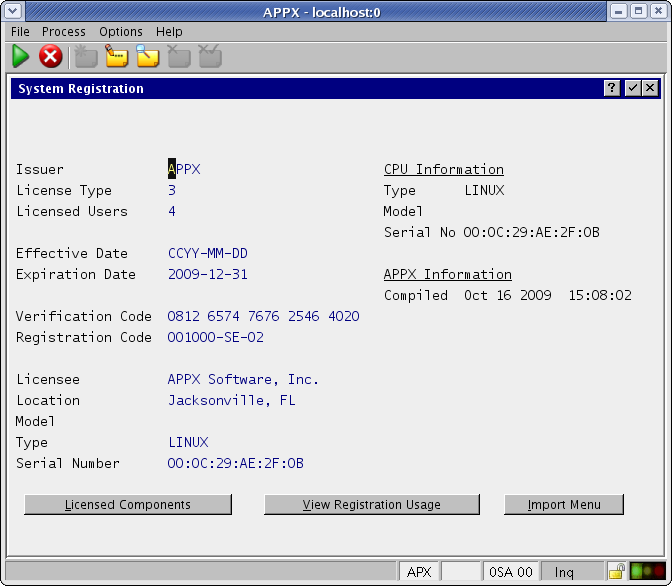 | |||||||
| > > |  | |||||||
| Changed: | ||||||||
| < < | After installing a new 5.0.0 License Key, your System Registration screen should include an Effective Date. | |||||||
| > > | After installing a new 5.x License Key, your System Registration screen should include an Effective Date. | |||||||
| Changed: | ||||||||
| < < | 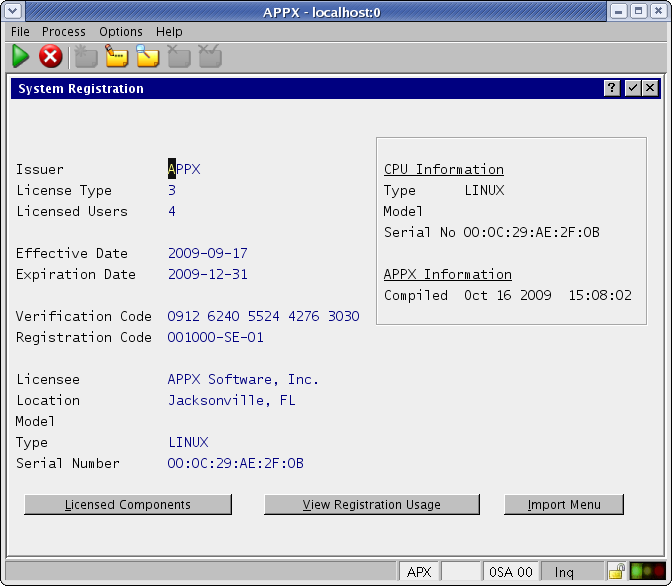 | |||||||
| > > |  | |||||||
Configure the new APPX Login ManagerAPPX 5.0.0 includes the new APPX Login Manager service. This service replaces the Connection Manager (appxd) which was included with APPX releases prior to APPX 5.0.0. The old Connection Manager will not work with APPX 5.0.0 and should not be used. You should remove appxd and start-appxd.sh from the tools directory since they are no longer needed. You should also remove any commands that might be run to start appxd during the boot process. | ||||||||
| Line: 177 to 177 | ||||||||
| up and running (process 31754 servicing port 8060) Installation Complete_ | ||||||||
| Changed: | ||||||||
| < < | After executing the above command, users should be able to use the APPX 5.0.0 Desktop Client to successfully login on port 8060. For additional information on managing APPX Login Services, please refer to the complete documentation. | |||||||
| > > | After executing the above command, users should be able to use the APPX 5.x Desktop Client to successfully login on port 8060. For additional information on managing APPX Login Services, please refer to the complete documentation. | |||||||
Final Tasks
| ||||||||
View topic | History: r23 < r22 < r21 < r20 | More topic actions...
Ideas, requests, problems regarding TWiki? Send feedback